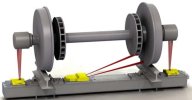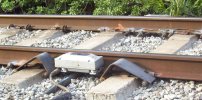I'm aware of that quote, but it still leaves some questions unanswered: what does "failed mode" mean? What is the process for returning from "failed mode" to normal operation?
An item of signalling equipment is in ‘failed mode’ when it has been determined that it is no longer working correctly.
The process of returning to normal operation depends on a number of factors, some of which are determined by the equipment involved.
With some types of axle counter equipment, the controlling signaller (following a set procedure) can attempt to reset a failed axle counter section or sections. With older types of axle counter equipment, only signalling (S&T) technicians can reset the axle counter section or sections.
Regardless, of who or how an axle counter section is reset, the signaller must follow a set procedure to ensure that the safety of trains is not compromised. Note however, that this is primarily about keeping trains separated from one another and preventing points from moving under trains, or other signalling related safety.
If an axle counter will not reset, then signalling (S&T) technicians will be called to investigate. They may investigate even if the axle counter did reset.
Axle counters are designed to detect the movement of a steel wheel (of a train) passing over the rail they are attached to. They are not designed to detect if the wheel is rotating. They are not designed to detect if the wheel is abnormal. Indeed, some other steel objects can cause an axle counter section to go from section ‘free’ to section ‘occupied’. When the signaller notices an axle counter section that is showing occupied but there is no train in the section, said axle counter section will be treated as failed.
I addressed this in my original post: "Stopping trains to inspect them is one piece of the solution, but it seems that better failure reporting from axle counter equipment, and a culture of fully investigating failures (whether the failure results from rolling stock or trackside equipment) also seem urgently necessary."
Inspecting trains is a (very!) good step, but I don't see how this would help with, say, detecting a failure in the axle counter itself that could lead to a train entering the block undetected.
If a the passage of a train results in multiple signalling equipment failures, then it’s logical to suspect that the train itself may be either the cause or contributing to the cause. Hence it may indeed be necessary to stop the train and ask the crew to inspect the whole length of the train looking for problems. Or it may be more appropriate to put it in a loop or sidings until appropriate train fitters/engineers can inspect it.
It’s beyond the current design requirements of axle counter equipment to report diagnostic information to a signaller. Even if this information was made available (where practical), the interpretation of the data requires engineering training. As axle counters are not designed to determine if a wheel is rotating, it’s simply not practical to try to use this equipment to reliability detect problems with wheels.
Axle counters, along with all of the rest of the safety-critical signalling equipment, are designed as far as is practical, to fail safe. That is, when they go wrong, the signalling equipment self protects by putting or holding signals to/at red/danger. Also called a ‘safe side’ failure.
Hence the possibility of an axle counter failing to detect a train has already been considered in great detail. Axle counter technology has been in use on the railways in the U.K. since the 1980s. Despite the PR from Network Rail, it’s not a new technology.
Safety-critical equipment should not be allowed to fail 3 times a year for a decade. (And to the extent that these "failures" are not actually an issue with the equipment, the equipment needs to provide better information to the signaler to make this clear.)
Safety critical signalling equipment in more than 99.999% of cases, fails ‘safe side’. As I described above.
Bear in mind that long track circuits (TCs), although indicating as a single one in the overseeing signal box, often have to be split up into three or four sections due to ground conditions, weather the track is subject to and other factors in order to work reliably, I wonder if in fact axle counters have a lower failure rate that the TCs they replaced?
Track circuits and axle counters work completely differently. Hence comparing the two directly is actually more difficult than you may imagine. As it depends on what and how you classify the various failures.
They have different failure mechanisms, different benefits and different weaknesses.
A track circuit doesn’t care how many trackworker steel toe caped boots or metal shovels pass over it (well, as long as no one sticks a shovel into a cable). But axle counters don’t like steel metal objects near the count heads.
A track circuit will go clear after a freight train pulls away even if one of the wagons rolled back over a IRJ when the locomotive had stopped. Some axle counters are less tolerant of this and may need to be reset.
Track circuits don’t like wet, dirty “ballast’ (or rather, what is supposed to be ballast) or flood water. Hence you get more track circuit failures when there is heavy rain in some places.
But track circuits in general, are in fact more than 99.999% reliable. It’s only certain track circuits that cause the vast majority of problems. And a lot of these problems could be solved if the railway sorted out the underlying problems and issues.
Most axle counters should also be more than 99.999% reliable. But there are a lot of new installations where the overall reliability has not been as good as hoped.
Perhaps more attention should be given to ensuring that hot axle box detectors can also pick up overheating between the wheel and the rail, particularly if the wheel is no longer rotating.
Most Hot Axle Box Detectors (HABD) in the mainland U.K. network are designed to monitor the temperature of the axle boxes, not the temperature of the wheels.
HABDs used in some other countries do have the facility to monitor the temperature of the wheels.


